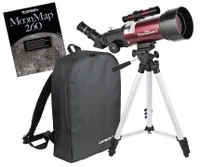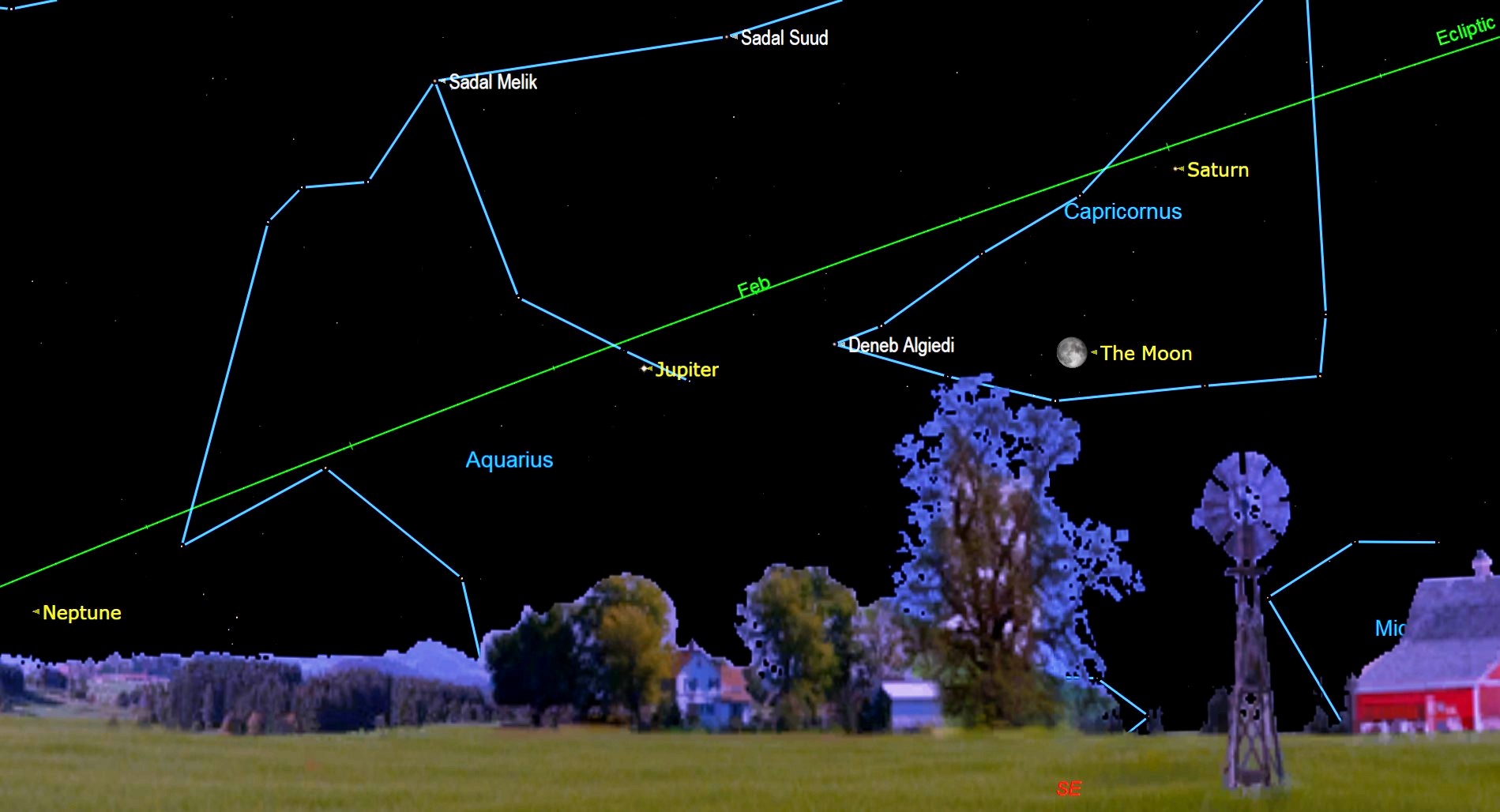See July's Full Buck Moon of 2021 rise tonight
July's full moon will soar high in the sky tonight and help you find the way to the planets Saturn and Jupiter.
While the official time of the July full moon is 10:37 p.m. EDT Friday, July 23 (0237 GMT Saturday, July 24), the moon will appear full through Sunday, NASA said in a skywatching roundup. So don't worry if you get clouded out on the night the moon is at its maximum illumination.
This month, you can use the full moon to point your way to Saturn and Jupiter, NASA said in the skywatching roundup. On Friday, the planet Saturn (bright in the July night sky) will be about eight degrees above the moon during morning twilight, in the southwest. For comparison, if you stretch your arm to its maximum and clench your hand into a fist, your fist is roughly 10 degrees across.
Related: How to Observe the Moon with a Telescope
Orion GoScope II 70 Telescope Moon Kit: $89.99 at Amazon
If you know a youngster who can't get enough of the moon, then they'll be delighted with views through the Orion GoScope II. Revealing craters and seas up close, this little telescope comes with a carry case and moon map.
You can find your way to Saturn by using your fist and looking for a bright object; planets tend not to flicker as much as stars. If you have a small telescope, you might be able to glimpse its rings.
If you're clouded out or otherwise miss the opportunity to see Saturn, the planet is still nearby the moon on Saturday night, roughly 7 degrees above during morning twilight. Then on Sunday night and Monday morning, the planet Jupiter will be about four to six degrees to the upper left of the moon, depending on when you look. Small telescopes may see the moons of Jupiter, depending on the equipment and local weather and darkness conditions.
Full moons happen when the moon is on the opposite side of the Earth from the sun. Full moons are not an ideal time to observe the lunar surface in detail due to the lack of shadows, and the moon also washes out the sky and makes it difficult to see faint objects.
Breaking space news, the latest updates on rocket launches, skywatching events and more!
Related: The Moon: 10 Surprising Facts
That said, the full moon is pretty and perfectly safe to look at with the unaided eye, and occasionally you'll get a special treat during full moon season. While the sun's light usually reflects off the surface of the moon during the full phase, although occasionally the positions of the moon and Earth align in such a way so that the moon passes through our planet's shadow.
This shadow-passing phenomenon is called a lunar eclipse, during which the moon turns red due to the stretched-out reddened light filtering through the edges of our planet's atmosphere and falling on the moon's surface. The next full lunar eclipse is in May 2022 and will be visible from North America.
The name "Buck Moon" arises from a traditional name from the Algonquin tribes, according to a NASA July 2021 moon guide, in what is now the northeastern United States, eastern Ontario and southern Quebec. That said, the moon may not be called the same name by all Algonquin peoples or by all Indigenous cultures; for example, another name attributed to the Algonquin for the July moon is the Thunder Moon. Rao names a few other Indigenous July moon names in his column.
Here is the cultural significance of July's full moon in select international areas, according to NASA:
- Europeans (traditional) called this the Hay Moon due to the haymaking season, and sometimes the Mead Moon.
- Hindus, Buddhists, and Jains may call July's moon the Guru Full Moon (Guru Purnima), "celebrated as a time for clearing the mind and honoring the guru or spiritual master," NASA said.
- Theravada Buddhists may call July's moon the Asalha Puha (also known as Dharma Day or Esala Poya – a festival celebrating Buddha's first sermon, NASA said). July's moon also marks the beginning of a three-month annual Buddhist retreat called Vassa.
- July's full moon falls in the middle of the sixth month of the Chinese calendar (during Héyuè, or Lotus Month) and Av in the Hebrew calendar, corresponding with the Israeli "holiday of love" Tu B'Av.
- In the Islamic calendar, the full moon is near the middle of Dhu al-Hijjah, the 12th and final month of the Islamic year. Dhu al-Hijjah is the month of the Hajj (the Festival of the Sacrifice). Muslims celebrated Eid-Al-Adha between July 20 and this full moon; Eid-Al-Adha honors Abraham's willingness to sacrifice his son to God, as told in the Bible and the Qu'ran.
Editor's Note: If you capture an amazing night sky photo and want to share it with Space.com for a story or gallery, please send images and comments to spacephotos@space.com.
Follow Elizabeth Howell on Twitter @howellspace. Follow us on Twitter @Spacedotcom and on Facebook.

Elizabeth Howell (she/her), Ph.D., was a staff writer in the spaceflight channel between 2022 and 2024 specializing in Canadian space news. She was contributing writer for Space.com for 10 years from 2012 to 2024. Elizabeth's reporting includes multiple exclusives with the White House, leading world coverage about a lost-and-found space tomato on the International Space Station, witnessing five human spaceflight launches on two continents, flying parabolic, working inside a spacesuit, and participating in a simulated Mars mission. Her latest book, "Why Am I Taller?" (ECW Press, 2022) is co-written with astronaut Dave Williams.



